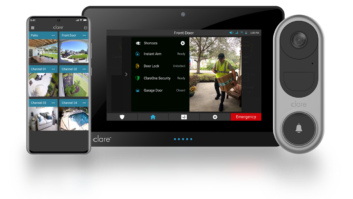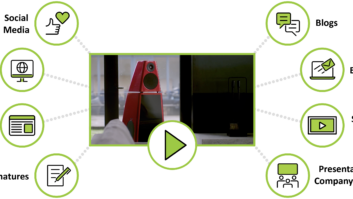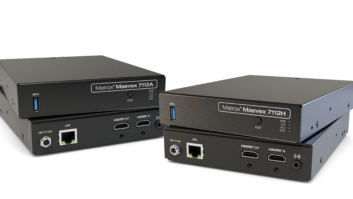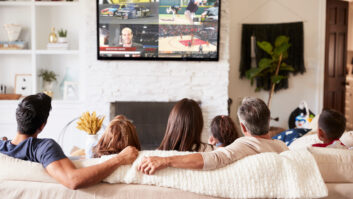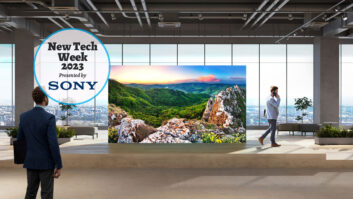After decades of waiting, the past few years have finally brought consumers a long-held dream that was once the stuff of science fiction or George Jetson’s house: A “TV” that’s so thin you can hang it on the wall. Every self-respecting movie about the world of the future had them, but that dream is no longer a fantasy, it is a reality that we sell our customers every day.
Of course, as is all too often the case with dreams, after we enjoy them, we have to wake up to reality. Yes, George Jetson did have that hang-on-the-wall screen…but wait just a minute! Unless his version of the future had a new-fangled version of Velcro that attached things weighing well over 150 pounds, just how did he get it on the wall?
Present or future, all of the new plasma and flat-panel display new kids on the block, along with their older CRT-based grandparents, just don’t jump on the wall and secure themselves. To take care of that, you will need a proper mounting system that not only accommodates the physical characteristics of the display, but the needs of the viewers, as well.
Let’s start with the notion of the appeal of flat-panel displays being based on their ability to hang on the wall. Where exactly does the client want the unit placed? From that, you need to take a look at where the center of the rear panel of the unit is, and go from there to find the studs to which the mounting hardware will be attached. Virtually all of the mounts sold today have a variety of mounting hole patterns that allow you to safely secure the mount no matter what the spread between studs, but check to make sure. In particular, as you get into the smaller LCD screens, their size may mitigate against being able to “hit” two studs, so the weight bearing capacity of the mount in relation to the unit’s weight needs to be considered if one-or both-of the sides of the mount need to be secured only to drywall.
Once you have assured yourself that the plate to be affixed to the wall can accommodate the panel’s weight and safely attach to the wall or structure, things begin to get interesting. Again remembering that the object here is to create the illusion of a wall hanging screen, examine the mount in question to determine how much depth it adds. Some mounts are thinner than others, depending on the nature of the construction of the plate and how the panel locks to it. Sometimes you need to get closer to the wall than others, and the “distance from wall” spec may sometimes be important.
Then again, there are times when you will need to provide for a range of adjustment in terms of tilt/pitch, pivot, roll, swivel or any combination of vertical, horizontal or off-axis shift. Mounts are available that accommodate those shifts, but keep in mind that the ability to adjust once comes at the penalty of being to install the panel very tightly to the wall.
How about those adjustments? Presuming once more that you have made the calculations needed to attach any mounting plate securely to the wall, what kind of adjustments will you want to make, and why? A good place to start is the amount of lateral movement allowed. Depending on the size of the panel, where the prime viewing spot is, the way the mount manufacturer designs their product and the location of the wall plate in relation to the wall studs, you may need to shift the panel horizontally to the left or right of dead center of the mounting plate, or perhaps vertically up or down from the mount’s mid-point. The amount of lateral movement may vary considerably, depending on the strength and type of rails used to support the panel. Remember that strength usually requires weight and strength, and those need to be factored into the equation. Also be careful to make certain that the wall mount itself does not become visible when you adjust the panel. If that happens, your issue is not in the type of mount used, but more likely where you decided to place it!
Another movement that is, to some extent, horizontal is the ability to pivot the display left or right on its center axis. This action is needed if the activities in the room mean that viewers may shift from one side of the display to the other, and the client wishes to move the panel so that people on one side of the room or the other have a better view.
Pivot is available to a wide range of adjustment, but more than any other adjustments it has the possibility to push the panel out from a flush mount. Simpler mounts stand the panel out on a boom arm and then provide a left/right pivot. More complex pivot mounts use a series of hinged swing or scissor-like arms that fold out from a more flush setting. These give you the advantage of not only pushing the panel back to the wall when it is not in use, but they allow for a wider range of pivot in return for what is usually a higher price due to the complexity of the mechanism. These multiple hinge arm mounts may also have weight limitations, so be careful.
Perhaps the most commonly requested axis adjustment is the ability to shift the panel on a horizontal basis downward toward, or upward away from being parallel to the wall. In most cases you will need to take advantage of this adjustment when the panel is mounted higher than center-to-eye level. This is called tilt or pitch, depending on the manufacturer’s lexicon, but the result is the same. Depending on the manufacturer, model, panel size and weight, and most importantly, that all important question of how far you are willing to mount the panel away from the wall, pitch/tilt adjustments range from a few degrees in either direction to over 15 degrees.
A final adjustment consideration is the need, if any, for a large enough degree of pivot such that you have moved more into the realm of what is more properly described as swivel or rotation. It is important, therefore, to understand the difference. Pivot, even for mounts that have a range of up to 180 degrees, is defined as being off a center axis and is usually achieved by having the panel attach to a solid beam going back to the wall.
Having defined the terms and seeing what type and range of adjustment they provide, your task is to match the capabilities of a mounting system against the installation requirement. These days, just about anything is possible as long as you always keep the room that this adjustment takes in mind. The mounts are there, but the space required to perform these gymnastic feats is considerably different when you are talking about a 17-inch computer monitor in the home office or a 22-inch-wide panel above the exercise equipment as opposed to a 60-plus-inch behemoth PDP.
Our discussion so far has been about how to mount the panel to the wall, but what about mounting the panel to the mount? That sounds obvious, but it hasn’t always been so. Although there is some standardization in the form of the VESA FPMPMI (Flat Panel Monitor Physical Mounting Interface) standard, that is mostly for smaller (under 22 inches) LCD panels. If you a panel is listed as FPMPMI compliant, all you need do is check to find out if you are dealing with the 75mm x 75mm mounting hole pattern or the larger 100mm x 100mm pattern. Most LCD panels use one or the other, making it easier to find attachment solutions from virtually all the major brands without the need for any custom metal work. Of course, should you find a non-compliant product, most of the brands have the ability to custom tailor something for you.
When it comes to larger PDP and LCD screens, things are not so standardized. In reality, most of the back-plates do have a variety of hole patterns, but not all plates fit all panels. To avoid fit and safety problems, check that any mount not only fits to the precise hole locations on the panel, but that it is rated for the panel’s weight and that the screws required fit the thread size and length requirements of the panel. This is not something you want to guess about, only to reach a job site to find that the mount doesn’t fit.
This does not mean that you have to use the mounts offered by the panel’s own manufacturer, though that is always a guaranteed to work option. It does, however, put the onus on you to explain to the client why you are choosing a third-party mounting system to accommodate one of the installation adjustment situations described above.
What if the mounting location isn’t directly to a wall? Creative installations for large panels may find them floating in the center of a room, disappearing into a cabinet or behind a picture frame, tilting down from under a kitchen cabinet, or somehow appearing out of the ceiling. Again, with the help of the suppliers and some imagination on your part, almost anything is possible.
At the beginning of the flat-panel revolution, this was the kind of stuff you had to build yourself, but now that’s no longer the case. Ceiling mounts from pipes are almost old school, as this has long been used as an option for front projection systems. The technique is the same, except that rather than attaching the pipe to secure a projector cage housing, it connects to a surround or back plate mount.
More simplistic, and undoubtedly more frequently used are the tilt-down mechanisms typically mated to small LCD panels for use in under counter applications. VESA 75 or 100 compatible, these manual flip mounts finally allow you to replace those bulky nine-inch, direct-view sets with something more modern. More importantly, a relatively inexpensive mount, specified and installed properly can help you sell your choice of higher priced LCD displays in more rooms in the home.
Even as we focus on the PDPs and LCDs of George Jetson’s world, keep in mind that sometimes the exercise room or children’s room still might not merit a flat panel, even in the most elaborate installation. The range and types of adjustment possible when you get a CRT set off the floor or out of the cabinet and on to the wall or ceiling due to their size, weight and bulk relative to a PDP or LCD of the same screen size. Nevertheless, do remember that wall mounts are not just for the new stuff; they are also available in a variety of options, sizes and brands to accommodate legacy CRT sets that you will have to deal with for many years to come.
Michael Heiss ([email protected]) is an industry consultant based in Los Angeles, California.


